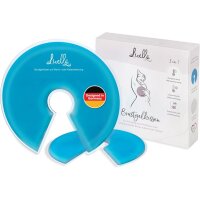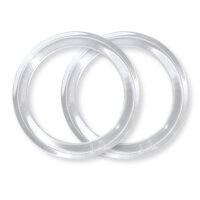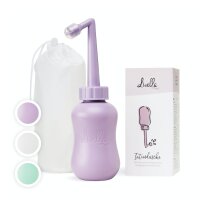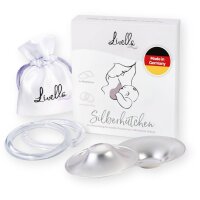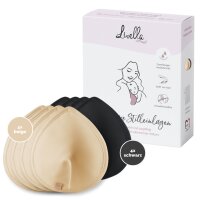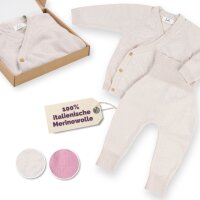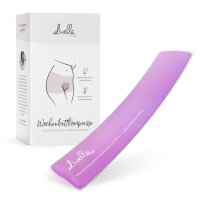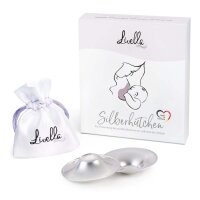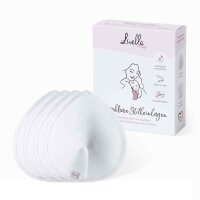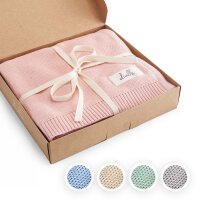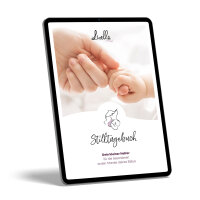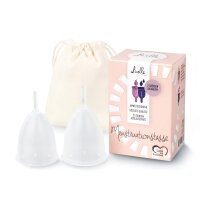When the moment of the first breastfeeding session comes around, many mothers discover that breastfeeding is anything but easy—no matter how much they prepared for it during pregnancy. Of course, there are some mother-baby pairs who are real naturals and hit it off well right from the beginning, but in most cases, it takes a little practice.
An important step towards breastfeeding success is learning how to get a good breastfeeding latch. But don't worry if you aren’t among those mothers for whom latching their baby on is intuitive. With a little patience, time and practice, you’ll master the art of positioning and attaching your baby correctly.
The good news is: If questions like “How do I get the perfect latch while breastfeeding?” or “How can I get my baby to latch deeper?” are currently on your mind, then you’ve come to the right place. In this blog post, we’ll tell you everything you need to know about proper latching when breastfeeding.
Table of Contents
Why is correct positioning and attachment important for breastfeeding?
Step-by-step guide to getting a good breastfeeding latch
What does a good breastfeeding latch look like?
What does a bad latch look like?
Common breastfeeding latch problems
Best breastfeeding position for a good latch
Conclusion: How to get a good latch when breastfeeding?
Why is correct positioning and attachment important for breastfeeding?
Getting the breastfeeding latch right is half the battle when it comes to successful breastfeeding. That’s because once your baby has latched on, everything else just happens naturally. But there are many more reasons why getting a good breastfeeding latch is crucial. These reasons include:
- Only when attached properly can your baby suck effectively.
- A good breastfeeding latch ensures that your little one gets enough breast milk and develops well.
- Proper latch-on prevents nipple pain—if your nipples become sore nonetheless, you can use silver nursing cups to treat them.
- Correct positioning and attachment allow your baby to empty your breast properly, which is important to keep your breast milk production up and prevent issues like blocked milk ducts, breast engorgement and mastitis.
- Good latch is the best way to prevent pain during feedings, which normally means that the breastfeeding relationship is kept up longer.

Step-by-step guide to getting a good breastfeeding latch
Bad latch can lead to a variety of different breastfeeding problems, which is why learning how to latch on properly is so important. Here is a step-by-step guide to help you succeed.
Step 1: Prepare everything
The first step is to prepare everything you might need during the feeding session with your baby. Otherwise, you might have to interrupt your baby's feed to grab a glass of water, a snack or something to distract you if the feeding turns out longer than expected.
Step 2: Get comfortable
No matter which breastfeeding position you choose, you should make sure to be comfortable. Use a nursing pillow and/or other pillows and cushions for support and put your feet up on a little stool when breastfeeding in a seated position.
Step 3: Bring your baby to your breast
Once you’re positioned comfortably, the next step is to gently guide your baby to your breast (and not the other way round because bending your upper body towards your baby can lead to back problems). Your baby’s body should be turned towards you with his or her face pointing towards your nipple. Check that your baby’s head and body are in a straight line.
Step 4: Get your baby to open his/her mouth
If your baby's nose is level with your nipple, let his or her head tip back slightly and wait for the mouth to open wide for latching. In this position, the baby’s chin should touch your breast while the nose is clear. You can stimulate your baby’s natural instincts by gently stroking the chin and lower lip.
Step 5: Pull your baby towards you
As soon as your baby has opened his mouth wide, bring him or her even closer to your breast so that the nipple slides deep into your baby’s mouth. Once your baby is latched on, your nipple should be placed in the region of your baby’s soft palate and much of the surrounding areola should have disappeared too.
Step 6: Check your breastfeeding latch once more
As soon as your baby starts feeding, you should take a few moments to check that you managed to get a good breastfeeding latch. We'll tell you what to look for in the next section.
Here are some additional breastfeeding latch tips:
- You can encourage your baby to open his or her mouth wider by gently tickling the lips.
- Support your baby’s neck, leaving the head free to move in different directions.
- Make sure that your baby’s lower jaw enters into contact with your breast first.
- Allow for skin-to-skin contact to get a good latch when breastfeeding.
- Support your breast if it’s too heavy or full and obstructs your baby’s nose.
What does a good breastfeeding latch look like?
Even though they methodically follow the different steps, many mothers still wonder whether or not they have managed a correct breastfeeding latch. Verifying that your baby is latched on correctly is something you should do every time you breastfeed—at least in the beginning.
Otherwise, you might still get it wrong and end up suffering from sore nipples or other breastfeeding problems. But how to know if your little one has latched on well?
Signs of a good latch include:
- The baby’s mouth is wide open.
- Your nipple is positioned deep in the baby's mouth.
- A good part of the areola is covered by the baby’s mouth and lips (especially by the lower lip).
- Your baby’s upper and lower lips are rolled outwards (like fish lips).
- Your baby’s chin touches your breast while his or her nose might make slight contact with your breast (but without being squashed against it).
- The tongue of your baby is cupped under your areola/breast.
- Your baby’s body is very close to yours and his or her head can move freely.
- You can hear your baby suck and swallow as he or she feeds.
- Your breasts feel emptier and softer after breastfeeding.
- More areola is visible above the upper lip than below the bottom lip.
- You don't experience any breastfeeding pain and your nipples are neither sore nor reddened nor deformed after feeding.
Good to know: If breastfeeding hurts even with a good latch, then the underlying cause of your pain might be of a different nature. Breastfeeding pain can have many different causes, and if it’s not due to poor latch, you should talk to a midwife or lactation consultant to determine where the pain comes from.
What does a bad latch look like?
Sometimes it can also be helpful to check for signs that your baby is not latching on well. But what does a poor latch look like? You can recognise a bad breastfeeding latch by the following signs:
- Your baby needs to turn his or her head to be able to grasp the nipple.
- Not much areola is covered by the baby’s mouth.
- Your baby’s lips are turned inward.
- Your baby’s cheeks aren’t full while feeding.
- You have a pinching sensation while your little one feeds.
If you detect any signs that your baby isn’t attached well, you should interrupt the feeding and start a new attempt to get a good breastfeeding latch. Remember to break the suction of the breastfeeding latch first before you take your baby away from your breast. To do this, carefully slide your little finger into the side of your baby's mouth and gently press down on his or her lower jaw.

Common breastfeeding latch problems
Even for mothers who know what aspects to pay attention to when it comes to breastfeeding latch, latching on can still pose problems. After all, it’s not just on the mother’s side that breastfeeding positioning and attachment must be correct, but on the baby’s side too.
Here are a few common issues that can prevent a good breastfeeding latch even though you’re doing everything right:
- Your baby refuses to open his or her mouth wide enough.
- You are not relaxed enough because you’re in a hurry or in pain or simply aren’t comfortable enough.
- Your baby turns his or her head away.
- You don’t hold your baby close enough.
- Your baby is frustrated and restless because the last feeding was too long ago.
- You don’t have enough skin-to-skin contact to activate your baby’s natural breastfeeding instincts.
- Your breasts are too full because you don’t feed often enough.
- Your baby has tongue-tie or a weak suck.
Best breastfeeding position for a good latch
There are various factors that influence which breastfeeding position works best for you and your baby. However, there’s one breastfeeding position that is particularly suitable for the early days because it makes getting a good latch for breastfeeding a lot easier, and that’s laid-back nursing.
Laid-back nursing, also known as biological nurturing, is a baby-led approach to breastfeeding that activates the baby’s natural breastfeeding instincts. As the name suggests, you sit down in a reclined position with your baby on your tummy. Your baby’s head should be level with your nipple. Ideally, the two of you share skin-to-skin contact—you can cover your baby with a soft baby blanket if you like.
Once positioned, you simply wait for your baby to find your nipple and latch on by him- or herself, which is why this technique is also called baby-led attachment or baby-led latching. It may take some time, but in the end you should get a good breastfeeding latch using this method.
The most important facts about laid-back nursing and breastfeeding latch:
- Activates your baby's natural instincts
- Starts with your baby on your tummy
- Ideally skin-to-skin contact between you and your baby
- Your baby needs to be able to move his or her head freely
Conclusion: How to get a good latch when breastfeeding?
Knowing how to latch on your baby correctly is the key to successful breastfeeding. Without proper attachment, your little one will struggle to get enough milk and may even cause you pain in the process. In many cases, getting a good breastfeeding latch is enough to prevent breastfeeding pain—be it pain caused by sore nipples, blocked milk ducts or mastitis.
Especially in the first few days, it’s important to pay close attention to your breastfeeding latch and positioning. Not only should latch-on be closely monitored in the process, but also afterwards when your baby is already feeding. Check if your baby’s mouth is wide open, if his or her lips are turned outwards and that the areola is mostly covered by mouth and lips.
If you’re still unsure whether your latch-on technique is correct, you can always get professional breastfeeding support. Ask a midwife or a lactation consultant to check your positioning and attachment and follow their advice on how to get a better breastfeeding latch.
References
- Breastfeeding: is my baby getting enough milk? - NHS (www.nhs.uk)
- Baby-led attachment | Australian Breastfeeding Association
- Breastfeeding: positioning and attachment - NHS (www.nhs.uk)
- Positioning & Attachment - La Leche League GB
- Baby-Led Latch: How to awaken your baby's breastfeeding instincts | Breastfeeding USA
- Your Guide to Breastfeeding (uncfsu.edu)
- Positioning & Attachment - La Leche League GB


